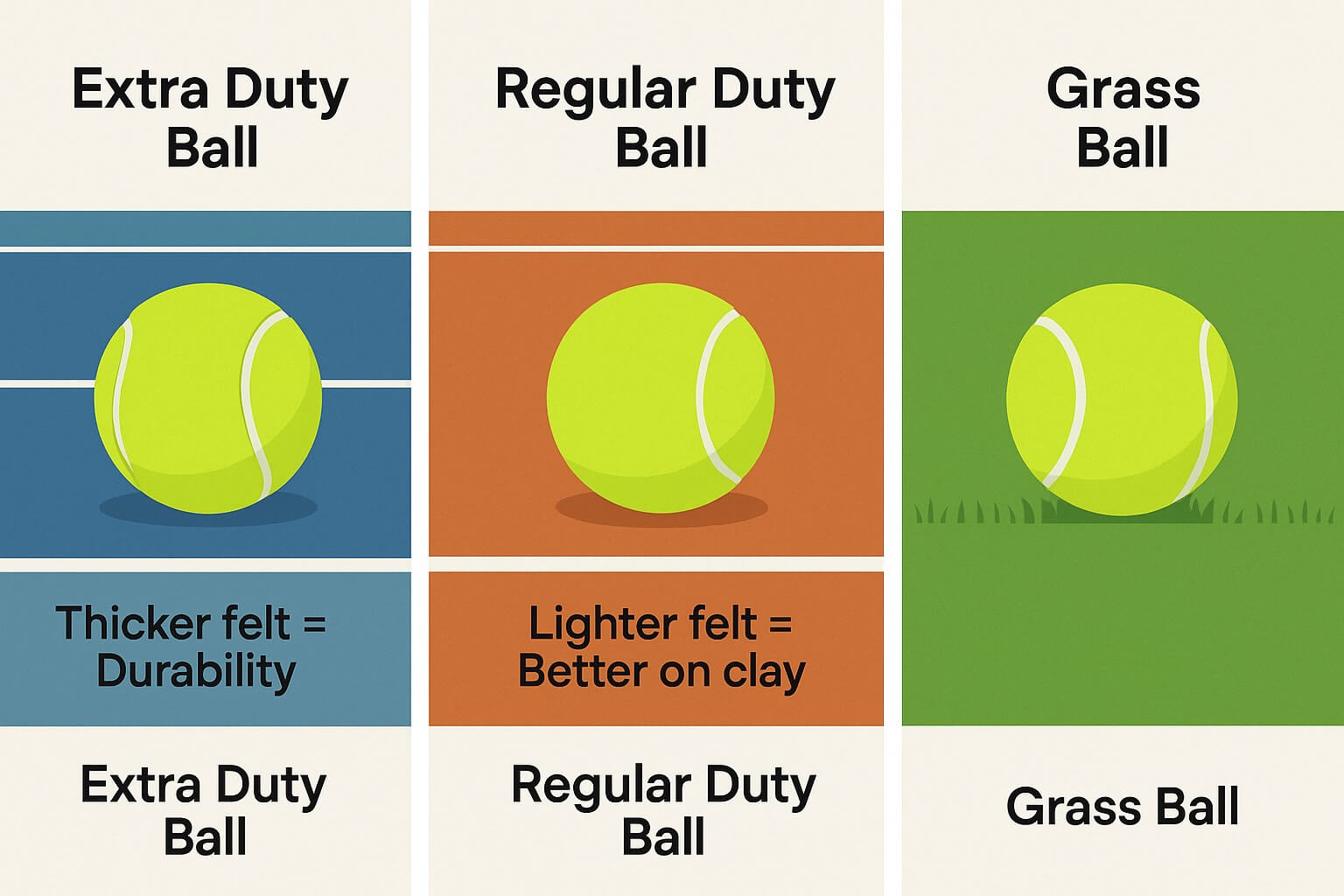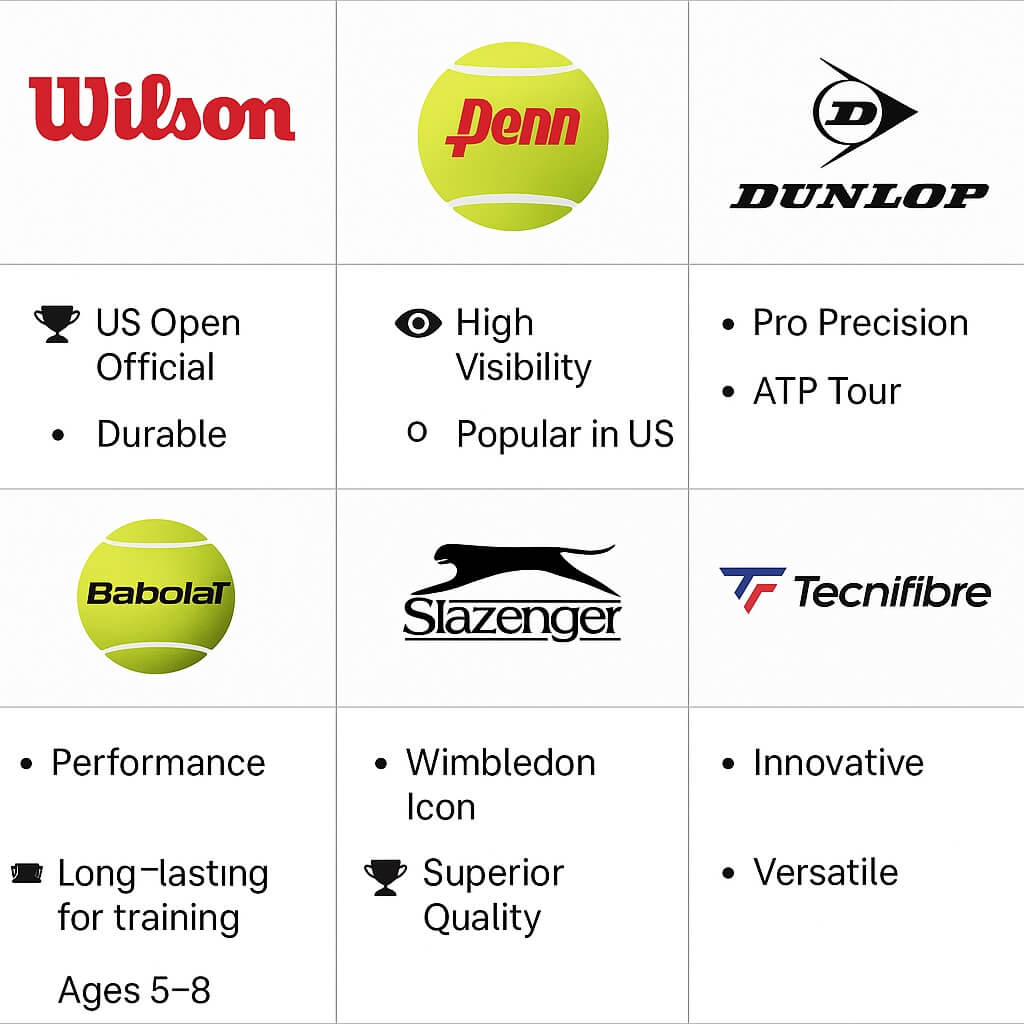Tennis balls are the unsung heroes of the sport, bouncing tirelessly through countless rallies and serving as the primary point of contact between players and the game. With so many types of tennis balls and so many different brands on the market, each promising optimal performance, durability, and consistency, it can be challenging to discern which ones truly stand out. One key question many players face thus is: How to choose the right tennis ball type and brand? In this guide we introduce some of the most prominent tennis ball brands and explain what makes each unique.
Before we jump into our brand review, let’s square some basics: Not all tennis balls are created equal, and the first big divide is between pressurised and pressureless models. Here is how they differ.

Pressurised Balls
These are the most common type of tennis ball. They are filled with air or nitrogen to give that lively bounce we all associate with fresh tennis balls. They feel crisp off the strings and are used in virtually every professional tournament. However, the big disadvantage of pressurised balls is that they lose pressure over time. And this can happen fast - within a couple of weeks of play. As a result they need to be replaced often which can be pricey and tracking their lifetime is also difficult.
Pressureless Balls
Instead of relying on internal pressure, pressureles balls are made from a denser rubber core base. They don’t “go flat” like pressurised balls. This makes them a popular choice for coaching, practice, and ball machines. They also actually have a firmer touch than pressurised balls, but are also less “lively” at first, and then become bouncier over time as the felt wears down. The big downside is that they behave differently from pressurised balls. In tennis tournaments however, pressurised balls are used. So ultimately you have to dial your game into the specific properties of pressurised balls.
Which ball type should you choose? If you are playing casually or training, pressureless balls may be more cost-effective. For match play and that authentic feel, stick with pressurized balls.

Extra Duty (Hard Court) Tennis Balls:
Extra duty tennis balls are specially made for the demands of hard courts. They’re covered with a thicker, more durable felt that can stand up to the rough, abrasive surface without breaking down too quickly.
This added durability means they won’t fluff out or lose their bounce as fast, so you can count on them to maintain performance over multiple hitting sessions. If most of your tennis is played on outdoor hard courts, extra duty balls are your best choice.
Popular options include the Penn ATP and Wilson Championship Extra Duty, both trusted by recreational players and pros alike for their resilience and consistency.
Regular Duty (Soft Court) Tennis Balls:
Regular duty tennis balls are made with a thinner, less dense felt, which makes them easier to play with on softer surfaces like clay and indoor courts. The lighter felt prevents the ball from picking up too much clay or fluffing out too quickly, keeping rallies smooth and consistent.
While they don’t hold up as well on abrasive hard courts, they’re perfect for the surfaces they’re designed for. If you mainly play on clay or indoors, regular duty balls will give you the best mix of performance and feel.
Well-known choices include the Wilson Roland Garros Regular Duty and Penn Championship Regular Duty.
Another factor to consider is court suface. The ball type you choose should also match the surface of the court you are playing on:
- Regular Duty Balls (aka pressurised balls): Designed for clay or indoor courts. The felt is thinner, preventing the ball from picking up too much clay dust and staying light during rallies.
- Extra Duty Balls: Built for hard courts, with thicker felt that resists the abrasiveness of the surface. They last longer but feel slightly heavier to hit.
- Grass Court Balls: Less common, but these are specially designed with an extra-resistant felt to handle the slick, fast conditions of grass.
Choosing the wrong type for your surface can lead to balls fluffing out quickly or losing bounce prematurely.
For kids and developing players, the International Tennis Federation (ITF) created a progression of balls that slow down the game and make learning easier. So if you wonder which balls are ideal for your kids, then follow their recommendations:
- Red Balls: 75% slower, larger, and softer. Perfect for ages 5–8.
- Orange Balls: 50% slower, slightly smaller than red, for ages 8–10.
- Green Dot Balls: 25% slower, close to full-size but easier to control.
- Yellow Balls: Standard tournament balls for advanced juniors and adults.
This progression ensures that kids build proper technique instead of struggling to control full-speed yellow balls too early.
Practice Tennis Balls
Practice tennis balls are built for durability and consistency, often using a pressureless design so they don’t lose their bounce as quickly as standard balls. This makes them perfect for long training sessions and for use in ball machines, where regular pressurized balls would wear out fast.
If you want to maximize court time without constantly replacing balls, practice balls are a smart investment. They may not feel as lively as match-quality balls, but they’ll keep your sessions productive and cost-effective.
Popular picks include the Gamma Bucket-O-Balls and Wilson Practice Balls, both trusted by coaches and players for everyday training.

Professional Tennis Balls
- Characteristics: Approved by professional tennis associations, these balls meet the highest standards for consistency, bounce, and feel.
- Use: Used in major tournaments and by advanced players seeking top performance.
- Examples: Wilson US Open, Dunlop Australian Open, Slazenger Wimbledon.
High Altitude Tennis Balls
- Characteristics: Designed for play at altitudes above 4,000 feet, where standard balls would bounce too high due to lower air density.
- Adjustments: These balls are slightly depressurized to counteract the high altitude effects, providing a more normal bounce.
- Use: Essential for players in mountainous regions to maintain standard play conditions.
- Examples: Wilson US Open High Altitude, Penn High Altitude.

Overview: Wilson is arguably the most recognized name in tennis, and its tennis balls are a staple at many major tournaments, including the US Open.
Key Features:
- Durability: Known for their long-lasting felt, Wilson balls maintain their bounce and texture longer than many competitors.
- Consistency: Players appreciate the reliable performance and feel, making it easier to predict ball behavior.
- Versatility: Wilson offers a range of balls suited for different surfaces, including clay, hard courts, and grass.
Popular Models: Wilson US Open, Wilson Championship, Wilson Triniti.
Overview: Penn, a subsidiary of Head, is another leading brand, particularly in North America. They are known for producing high-quality tennis balls for all levels of play.
Key Features:
- Visibility: Penn balls are known for their bright, optic yellow color, enhancing visibility.
- Playability: Designed for consistent performance, Penn balls are popular in both recreational and professional circles.
- Durability: The extra-duty felt versions are particularly resilient, ideal for hard court play.
Popular Models: Penn Championship, Penn Pro Marathon, Penn ATP.
Overview: Dunlop has a long history in tennis, and its balls are renowned for their exceptional quality and performance. Dunlop is the official ball of the Australian Open and the ATP Tour.
Key Features:
- Precision: Dunlop balls are engineered for precise flight and bounce, catering to professional standards.
- Advanced Technology: Incorporates technologies such as HD Pro Cloth and HD Core for enhanced durability and performance.
- Versatility: Offers specific models for different court types and playing conditions.
Popular Models: Dunlop ATP, Dunlop Australian Open, Dunlop Grand Prix.
Overview: Babolat, a French company, is best known for its racquets, but its tennis balls are also highly regarded, especially in Europe.
Key Features:
- Performance: Babolat balls are designed for high-level play, with excellent control and consistency.
- Durability: High-quality felt and construction ensure these balls last longer.
- Innovation: Continually innovates to meet the demands of competitive play.
Popular Models: Babolat Team, Babolat Gold, Babolat Roland Garros.
Overview: Slazenger is synonymous with Wimbledon, where its balls have been the official choice for over a century. This legacy brand offers a blend of tradition and innovation.
Key Features:
- Quality: Known for premium quality, Slazenger balls offer superior feel and performance.
- Consistency: The balls are rigorously tested to ensure consistent bounce and flight.
- Prestige: Slazenger's association with Wimbledon lends the brand a unique prestige.
Popular Models: Slazenger Wimbledon, Slazenger Open, Slazenger Ultra Vis.
Overview: Tecnifibre is a French brand that, while less known than some others, has carved out a niche with its high-performance tennis balls.
Key Features:
- Innovation: Known for innovative technologies that enhance durability and playability.
- Consistency: Offers consistent performance, catering to serious players.
- Specialization: Provides balls tailored to different surfaces and playing styles.
Popular Models: Tecnifibre X-One, Tecnifibre Club, Tecnifibre Court.
When selecting a tennis ball, consider the following factors:
- Playing Surface: Choose extra duty for hard courts and regular duty for soft courts.
- Skill Level: Training and practice balls are ideal for beginners, while standard and professional balls suit more advanced players.
- Altitude: Use high altitude balls if you’re playing above 4,000 feet.
- Frequency of Play: Pressureless balls are great for frequent practice sessions due to their durability.
The choice of tennis ball can significantly impact your game, from the feel of the ball on your racquet to its bounce on the court. Whether you're a casual player or a seasoned pro, understanding the strengths of each brand can help you make an informed decision and enhance your tennis experience. Brands like Wilson, Penn, Dunlop, Babolat, Slazenger, and Tecnifibre each offer unique attributes that cater to different playing styles and preferences, ensuring there's a perfect tennis ball out there for everyone.
What’s the difference between regular duty and extra duty tennis balls?
Regular duty balls are made with thinner felt, making them ideal for clay and indoor courts where the surface is softer. Extra duty balls use thicker, more durable felt to withstand the abrasiveness of hard courts. Using the wrong type can cause balls to wear out or lose performance much faster.
Why do tennis balls lose their bounce?
Pressurized tennis balls lose air gradually after being opened, which reduces their bounce and liveliness. This can happen in just a few weeks of regular play. Pressureless balls don’t rely on internal air pressure, so they maintain their bounce for much longer, although they feel firmer when new.
How long do tennis balls last?
It depends on how often you play and the type of ball. Pressurized balls may last 1–3 sessions for competitive play before losing their peak performance, while pressureless or practice balls can last for months of training. Tournament players typically open a new can every match.
What tennis balls are best for beginners?
Beginners and kids often benefit from low-compression balls such as red, orange, or green dot balls. These are slower, softer, and easier to control, helping players build confidence and proper technique. Adults who are just starting out can use standard pressurized balls but may prefer practice balls for longer durability.
Do I need special tennis balls for high-altitude play?
Yes. At elevations above about 4,000 feet (1,200 meters), regular balls fly faster and bounce higher due to thinner air. High-altitude balls are manufactured with less pressure inside to keep the bounce and feel closer to normal.

















